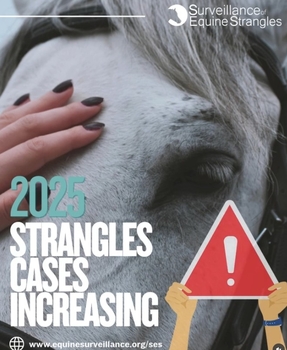Spotting the Signs of Strangles: What Every Horse Owner in the UK Should Know
Wednesday 15 October 2025

Strangles is one of the most dreaded infectious diseases in the equine world. Yet despite its notoriety, early detection and strong biosecurity protocols can make a big difference in limiting its spread. The Equine Infectious Diseases Surveillance (EIDS) team has published a concise yet comprehensive guide on recognising and managing strangles — let’s walk through the key points and what they mean for you and your horses.
(Source: EIDS “Spotting the Signs of Strangles”) Equine Surveillance
What Is Strangles?
- Strangles is a highly infectious disease caused by the bacterium Streptococcus equi (S. equi).
- It can affect horses of all breeds and ages, and is consistently one of the most commonly diagnosed infectious diseases in equines globally.
- Because of its contagious nature, once one horse is infected, there’s a real risk of transmission to others — making strict disease control measures essential.
- Historically, the disease has been known for centuries, though the specific causative bacterium was identified in the late 19th century.
How Does Strangles Spread?
Understanding the ways strangles spreads is critical to preventing outbreaks:
- Direct contact: Horse-to-horse, particularly via nose-to-nose contact or shared proximity.
- Indirectly via equipment and environment: Tack, feed buckets, grooming tools, yard furniture — even handlers’ clothing or hands — can carry the bacteria.
- Water sources: S. equi can survive in water for 4–6 weeks. If an infected horse contaminates a shared water source, that can become a reservoir for infection.
- Importantly, strangles is not primarily airborne like influenza; large droplets containing the bacteria typically do not travel far.
Because as few as 1,000 bacteria can initiate infection, even a small contamination can be enough.
Recognising the Clinical Signs
Early detection is crucial, so be familiar with the following common clinical signs (which generally emerge 3–21 days after exposure): Equine Surveillance
|
Symptom |
What to Look For |
|---|---|
|
Fever |
Temperature ≥ 38.5 °C |
|
Lethargy & loss of appetite |
Affected horse appears dull, off food |
|
Nasal discharge |
Often thick, purulent (“pus-like”) |
|
Swollen lymph nodes |
Especially in head/neck region — may progress to abscesses |
|
Abscess formation with rupture |
Abscesses may drain externally or into the guttural pouches, producing yellow “custard-like” pus |
|
Coughing & ocular discharge |
May accompany infection in some cases |
It’s worth emphasising: horses generally become infectious about two days after the onset of fever. That’s why monitoring temperature is such a key early defence.
If a horse shows fever or other suspect signs, isolate immediately and seek veterinary advice rather than wait.
The Hidden Risk: Carriers
Even after recovery, about 10% of horses may become carriers of S. equi.
- These horses may appear perfectly healthy and resume normal routines.
- However, they can intermittently shed the bacterium (for example from the guttural pouches) and thus serve as a low-level source of infection.
- Abscesses that haven’t fully drained, or hardened pus “chondroids,” are possible reservoirs inside the guttural pouches.
Hence, clearing clinical signs does not necessarily mean a horse is free from risk. Regular testing and monitoring may be needed, especially after an outbreak.
Outbreak Management: The Traffic Light Approach
When strangles strikes, having a clear plan is essential. EIDS recommends a traffic light system to group horses and manage risk.
- Red group: Suspected or confirmed cases
- Completely separated from other horses
- Use dedicated equipment, feed, water
- Handlers should attend them last to prevent spread
- Amber group: Horses that have had contact with infected individuals within the last ~3 weeks
- Monitor temperature twice daily
- At first sign of fever (≥ 38.5 °C), move them into Red
- Handlers should attend them after the “green group” but before Red
- Maintain vigilance with twice-daily temperature checks
- Any fever → immediate isolation / move to Red
- Handlers attend these horses first in any routine
- Green group: Horses with no known contact or risk
The principle is clear: attend to the lowest risk first, highest risk last; never let disease travel via your routines. The earlier a suspected case is isolated, the more effectively the outbreak can be contained.
Vaccination: A New Tool
Vaccination is a powerful addition to the horse owner’s toolkit — though not a standalone fix.
- A newer vaccine, Strangvac, has become available in Europe and offers an extra layer of protection.
- It is particularly recommended before periods of higher risk — for example, before moving premises or attending events.
- Using it during or after an outbreak may also be beneficial, especially to boost immunity in the “green group.”
However, vaccination should complement — not replace — strong biosecurity, prompt isolation, surveillance, and good yard management.
What You Can Do — A Checklist for Horse Owners
- Monitor temperatures regularly, especially after travel or exposure to other horses
- Isolate any horse showing fever or suspect signs immediately
- Implement the traffic light system and strictly adhere to it
- Use separate equipment, feed, water troughs for groups of different risk
- Clean and disinfect tack, buckets, grooming tools between uses
- Be cautious with shared water sources — the bacteria can persist for weeks
- Consider vaccination (e.g. Strangvac) as part of a broader prevention strategy
- If carrier status is suspected, consult your vet about testing or further monitoring
Final Thoughts
Strangles remains a formidable threat to equine health and welfare, but it’s far from uncontrollable. With vigilance, prompt veterinary engagement, sound biosecurity measures, and clever grouping strategies, the risk can be managed effectively.
If you ever have concerns about your horse’s health, seek veterinary advice without delay. Early detection and response can make all the difference.
Stay informed on diagnoses vis the EIDS Surveillance of Equine Strangles website.

 c. KT Equine Photography.jpg)




